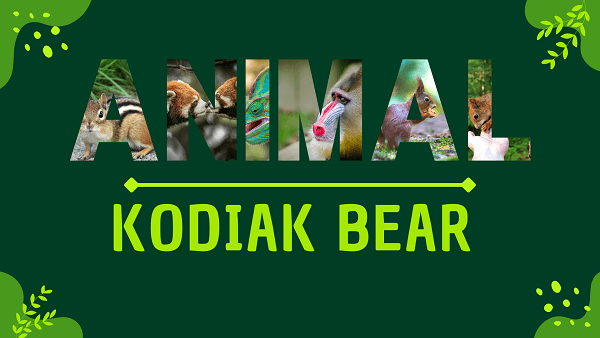Kodiak Bear | Facts, Diet, Habitat & Pictures
Home » Animals » Kodiak Bear | Facts, Diet, Habitat & Pictures
Kodiak Bear Overview
Appearance
The Kodiak bear, a subspecies of the brown bear, is a massive and imposing creature. It boasts a thick and shaggy coat that can range in color from dark brown to nearly blonde. These bears have a robust build, strong legs, and large, rounded ears.
Their distinctive hump of muscle on their shoulders helps power their formidable strength. Kodiak bears are known for their enormous size, often standing over 10 feet (3 meters) tall when on their hind legs.
Origins And Evolution
The Kodiak bear, Ursus arctos middendorffi, has a long evolutionary history that can be traced back to the Pleistocene epoch. It is a subspecies of the brown bear, adapted to the unique conditions of the Kodiak Archipelago in Alaska.
Over millennia, these bears evolved to become the largest of all brown bears due to abundant food resources and isolation. Their massive size is an evolutionary adaptation to compete for limited food and maintain dominance in their ecosystem.
These bears share a common ancestor with other brown bears and polar bears, with genetic adaptations shaped by their specific habitats and diets. Their survival relied on versatile foraging skills and hibernation behaviors that allowed them to thrive in the challenging subarctic environment.
Behavior and Lifestyle
Kodiak bears are generally solitary animals, and their behavior is influenced by their need to secure food resources. They are omnivorous, with a diet consisting of salmon, berries, plants, and occasionally carrion.
Their lifestyle revolves around the seasonal availability of food, with salmon runs being a significant event. Kodiak bears are excellent swimmers and are often seen hunting for fish in rivers and streams. They are also known for their hibernation behavior during the harsh winter months when food is scarce, relying on their stored fat reserves to survive until spring.
Kodiak Bear Scientific Classification
- Kingdom: Animalia
- Phylum: Chordata
- Class: Mammalia
- Order: Carnivora
- Family: Ursidae
- Genus: Ursus
- Species: arctos
- Subspecies: middendorffi
Kodiak Bear Locations
- Kodiak Archipelago, Alaska, USA
- Parts of southwestern Alaska, including the Alaska Peninsula
- Coastal regions of Alaska
Fast Facts
- Name: Kodiak Bear
- Scientific Name: Ursus arctos middendorffi
- Habitat: Coastal regions, Islands
- Diet: Omnivorous, Fish, Berries
- Physical Features: Massive size, Thick fur
- Nocturnal: Diurnal, Crepuscular
- Solitary: Largely solitary
- Unique Order: Carnivora
- Lifespan: 20-25 years
- Conservation Status: Least Concern
- Fun Facts: Largest brown bear, Excellent swimmers
Physical Characteristics
- Color: Brown, Blonde
- Skin Type: Fur-covered
- Top Speed: 35 mph
- Lifespan: 20-25 years
- Weight: 360-680 kg
- Length: 2.4-3 meters
- Age of Sexual Maturity: 5-6 years
- Age of Weaning: 2-3 years
Kodiak Bear FAQs
What is a Kodiak bear?
The Kodiak bear is a subspecies of the brown bear, known for its massive size and found primarily in the Kodiak Archipelago of Alaska.
How large can Kodiak bears grow?
Kodiak bears are among the largest bears globally, with adult males weighing up to 1,600 pounds (730 kilograms) or more.
What do Kodiak bears eat?
They are omnivorous, with a diet that includes salmon, berries, plants, carrion, and occasional terrestrial mammals.
Are Kodiak bears nocturnal or diurnal?
Kodiak bears are primarily diurnal, meaning they are active during the day.
Do Kodiak bears hibernate?
Yes, they are known to hibernate during the winter months when food is scarce, relying on stored fat reserves to survive.
Related:
- Tarantula
- Mackerel
- Mackerel
- Sea Stars
- Bird
- Amphibians
- Vertebrates
- Sand Dollars
- Barnacles
- Scallop
- Brittle stars
- Tilapia
- Carp
- Krill
- Catfish
- Grouper
- Calm
- Yak
- Yucatan Brown Brocket
- White-tailed Deer
- Uakari
- Utahraptor (Dinosaur)
- Qinghai Lake Naked Carp
- Qilian Shrew
- Qinling Panda
- Qacha’s Nek long-fingered Frog
- Red Fox
- Red Panda
- Rockhopper Penguin
- Salamander
- Snail
- Storks
- Jacana
- Junglefowl
- Jabiru Stork
- Junco
- Japanese Crane
- Kudu
- Kingfisher


